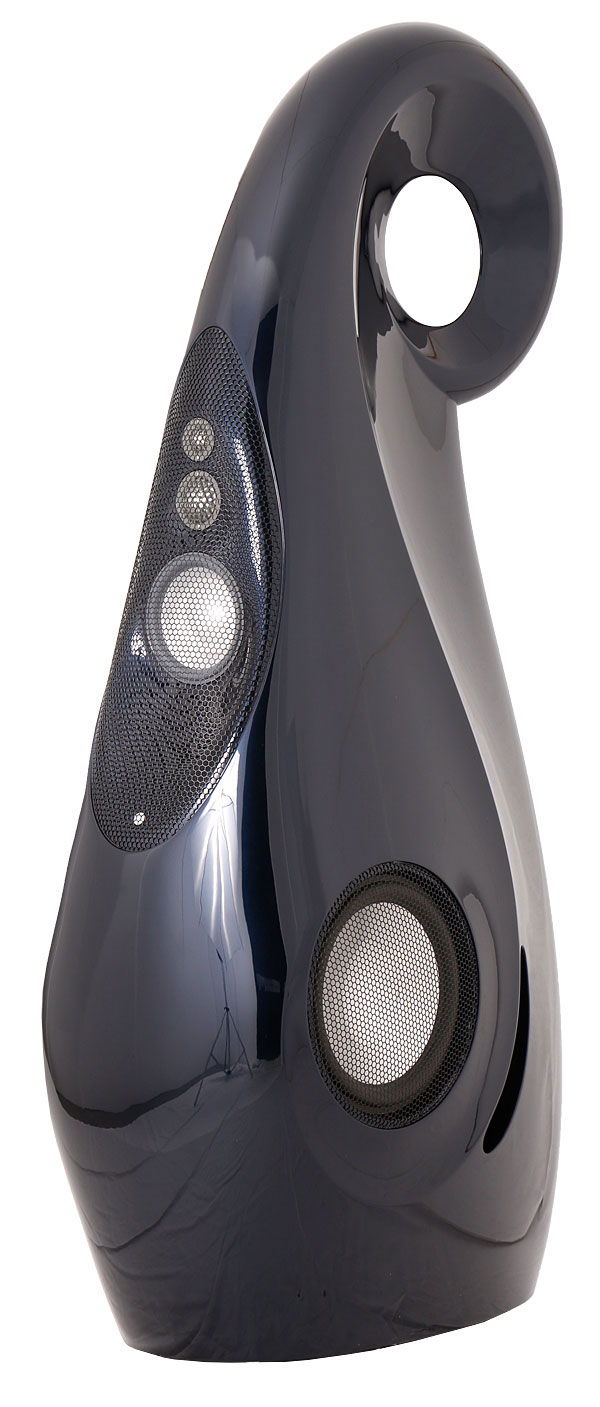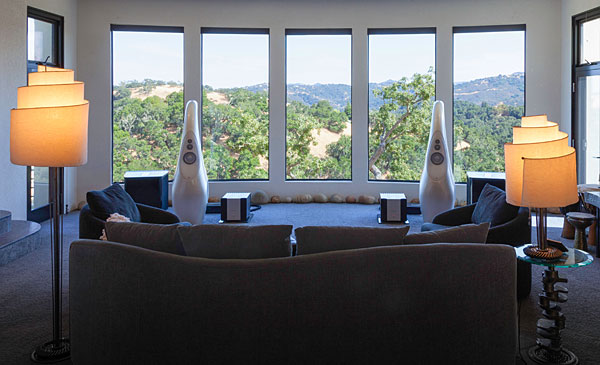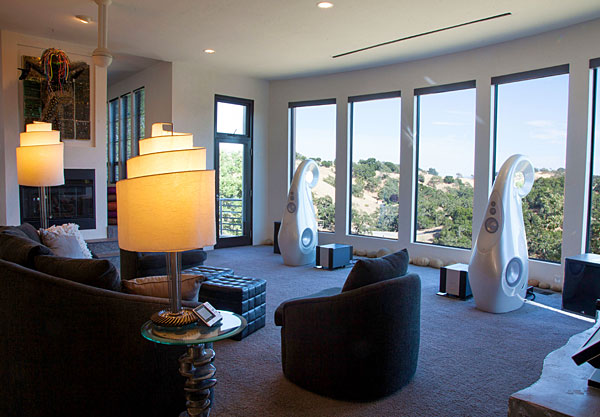| Columns Retired Columns & Blogs |
Please add a working link to WP's review of the original G1. Thanks.
After all that, in the weeks following O'Hanlon's visit, I continued to fine-tune the Spirits' positions and toe-in angles. Bass was the way I like it. Tonality was spot-on and very realistic, but I was looking for the optimal balance between razor-sharp depiction and soundstage size and depth. My quest ended with a magnificently big sound but not the tightest imaging. Instruments and voices still hung in space as they should, but each was more rounded and slightly more diffuse than the images produced by my MartinLogans electrostatics. This was not necessarily a bad thing.

Lending an ear or two
Chelsea Williams' Boomerang (CD rip, Blue élan) begins with a haze of hammered dulcimers before a panoramic orchestra of sounds falls in behind her commanding voice—a rich, honeyed voice that draws the listener directly in, and greatly reminds me of Americana-flecked favorite First Aid Kit. It's love at first listen—the entire album is a hidden gem of 2017. Through the Giya G1 Spirits there was deep bass and layers of acoustic and electric instruments, and Williams's well-recorded voice was locked in place, front and center, wonderfully rendered.
As a result of my setting up the Spirits to suit my preferences in sound, the size and depth of this recording were slightly bigger than life. But in this case, mo' Chelsea mo' betta! It was almost the perfect album to show off what the Vivids got so right: natural, even tonality all across the midrange, with a cohesive soundstage from left to right and from front to back. There was no spittiness, no artificial sheen or edge on anything. No matter how loud I turned them up, the Spirits hung everything together and refused to act out.
"Afterglow," from Lydia Ainsworth's Darling of the Afterglow (16/44.1k file, Arbutus), eventually became the first track I played when anyone wanted to hear the Spirits. Sitting somewhere between Kate Bush, Peter Gabriel, and Lana Del Rey, "Afterglow" launches with deep bass pulses and droning voices, before Ainsworth's carefully multitracked voice hovers in the room as the bottom end drops right out. A pal has described this track as a series of low-frequency test tones with voice. It works for me. (If you're curious, watch the video on YouTube.)
This was the Giya G1 Spirit's sweet spot: big, full-range, dynamic sound, with a hint of extra charm on top. When I played this track loud, people wanted to hear it still louder; and as I pushed the volume up, there was no brightness or glare. "Afterglow" is that rare track that's simultaneously huge and intimate, and the Spirits presented everything in thrilling detail and depth. The music may not be your cup of tea, but I wish every reader could hear this track through the Spirits, and get the pure musical rush they could deliver with a recording so accomplished and rich.
I also played "Afterglow" when the audio club visited, and several members whipped out their phones to take photos of the album cover, for future reference. Demo track of the year? After that meeting, member Kris Vardas, himself a promising amateur speaker designer, wrote on our club's Meetup.com page: "Listened to my audio system for the first time since hearing the Vivid G1s at Jon's house. In comparison, my floorstanders sound like small bookshelf speakers." I think he exaggerates, but it does touch on why the Spirits are so seductive.

Anyone who's visited my listening room knows we love BIG BASS around these parts, and normally run our two powered subwoofers all the time. But I turned them off while we were setting up the Spirits, then never turned them back on. Though the very bottom octave was a bit shy by powered-sub standards, there was no need to add the big boys back in—across the board, the Spirits laid down a solid, room-shaking foundation that was both musical and tight. Okay, so maybe Dickie snuck in a little extra bottom end down there in the lower to midbass? Here's where the external crossover would let you add some active electronics, so you could fine-tune to taste.
We ran all the usual big-bottom suspects, from Gentlemen's Dub Club to Dub for Daze to Dub Vibes to Dubblestandart, and on to electronic, trip-hop, Mahler, and everything in between. Always rewarding, always satisfying. I'll put it this way: If you really don't like bass (I'm guessing there are a few of you out there), these are not the speakers for you. The Vivids gave great weight and impact to rock and large-scale classical music alike. Yet when I scaled my playlist back to more acoustic fare, such as Yusuf/Cat Stevens's excellent new album, The Laughing Apple (24/44.1k file, Verve Decca Crossover), the bottom end got out of the way to let the supple midrange do its thing, floating his voice in space and bringing it to life.
Classical piano, small chamber, and full orchestral arrangements were all in the mix the last couple months, and though they all sounded wonderful through the Spirit, the Vivid's attributes shone brighter with modern music, rock in particular. With a chamber orchestra given a lively recording, such as Rachel Podger's masterful take on J.S. Bach's violin concertos with Brecon Baroque (SACD/CD, Channel Classics 30910), the entire ensemble took on a lovely liquid quality, the trade-off being that the instruments themselves were not as distinctly layered in space as I've heard through other speakers. With this many musicians on stage, this layering becomes more critical.
The Vivids' sound remained smooth and consistent when I listened vertically or horizontally off axis, with a slight top-end rolloff the farther I moved to one side. The sweet spot was of generous size—images held steady as I moved a few feet to either side of the center seat, or even stood up. I also found the Spirits could maintain a uniform sonic signature, including the bass, no matter where I set the volume—something that isn't often tested, but that I've found humbles many otherwise promising products.
Robert Plant's new album, Carry Fire (24/96 file, Nonesuch), is what I call bang-and-strum music: hand drums and drum kits keep the pulse while guitars and other, more exotic stringed instruments layer the chords. Above it all, Plant croons in his plaintive boy-lost-in-the-woods voice. Carry Fire is not a great recording, but it turned out to be a good album for evaluating various playback levels: at low volumes, Plant's voice retained all its characteristics in the same proportion as at live levels. With some speakers, vocal overtones and richness push forward or recede, depending on the volume. Not here.

Compared to what
In recent months I've heard plenty of pricey competing speakers set up to sound fantastic in a variety of settings: the Wilson Audio Specialties' Alexx, YG Acoustics' Sonja 1.3, various Magicos, and, for much less money, Rockport Technologies' Avior II and Vienna Acoustics' The Music, to name a few favorites.
Vivid's Giya G1 Spirit fits easily in this rarified company. If I had to draw a general conclusion, I'd say that, of the speakers mentioned above, the Spirits were more easygoing on top, while a tad less exacting in imaging and the layering of soundstage depth. But the Spirit's dynamic impact at loud levels was better than anything I've heard. The YGAs easily better the Vivids in precise holographic imaging—but I've never heard the Sonja 1.3s rock out like the Giya G1 Spirits.
Comparing the Vivids to MartinLogan's superb Masterpiece Renaissance ESL 15As, which spent several happy months in my room earlier this year—along with their self-powered 12" woofers—it was readily apparent that the Vivids had more bottom end. The MLs do have an active bass-calibration system to bring things in line, while the Vivids' bass reproduction is subject to placement more than anything else—and we'd placed the Spirits where the bass was standing proud! But while the MLs had plenty of openness and detail and tight imaging, they could never render loud rock as dynamically and as easy to listen to as could the Vivids.
Conclusions
Vivid's Giya G1 Spirits could rock, and often inspired me to dive all in. And with a great recording, the closer to realistic levels I pushed them, the better everything sounded. At the same time, simple vocal recordings played softly, late at night, sounded sublime. A real treasure, that.
The Giya G1 Spirit is like a rich, robust cup of coffee with a bit of milk and sugar. Is that extra bit of sweetness a distraction? There were times when I might have preferred my music rendered straight, with all details intact. But with most real-world recordings this was rarely a problem—and with dodgy recordings, a little sugar goes a long way.
As if on cue as I wrote this up, Stereophile reader "blang11" commented, on the online reprint of John Atkinson's review of KEF's Reference 5 loudspeaker: "I struggle to remember the last speaker review I read in Stereophile that described the sound as a bit too sweet. I recall the majority are either neutral (yay!) or overly bright or the tweeter is simply a few [dB] too high in level. As someone who has recently moved into a room that's a bit bright, I now recognize that a bit of sweetness can be just what the doctor ordered, especially for those whose recordings aren't impeccable."
That's the Spirit!

Please add a working link to WP's review of the original G1. Thanks.

John, sounds like you need a Dayton DATSv2